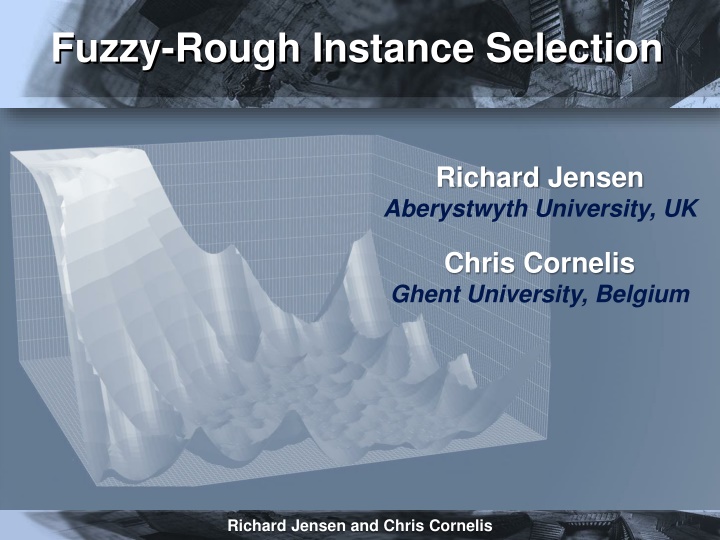
Fuzzy Rough Instance Selection Research
Explore the significance of instance selection in knowledge discovery through fuzzy-rough sets theory. Richard Jensen and Chris Cornelis discuss the challenges posed by excessive data and the role of instance selection in data mining algorithms. Discover the basic concepts and applications in instance selection and rough set theory.
Download Presentation

Please find below an Image/Link to download the presentation.
The content on the website is provided AS IS for your information and personal use only. It may not be sold, licensed, or shared on other websites without obtaining consent from the author. If you encounter any issues during the download, it is possible that the publisher has removed the file from their server.
You are allowed to download the files provided on this website for personal or commercial use, subject to the condition that they are used lawfully. All files are the property of their respective owners.
The content on the website is provided AS IS for your information and personal use only. It may not be sold, licensed, or shared on other websites without obtaining consent from the author.
E N D
Presentation Transcript
Fuzzy-Rough Instance Selection Richard Jensen Aberystwyth University, UK Chris Cornelis Ghent University, Belgium Richard Jensen and Chris Cornelis
Outline The importance of instance selection Rough set theory Fuzzy-rough sets Fuzzy-rough instance selection Experimentation Conclusion Richard Jensen and Chris Cornelis
Instance selection Knowledge discovery The problem of too much data Requires storage Intractable for data mining algorithms Removing data that is noisy or irrelevant Richard Jensen and Chris Cornelis
Rough set theory Upper Approximation Set A Lower Approximation Equivalence class Rx Rx is the set of all points that are indiscernible with point x Richard Jensen and Chris Cornelis
Fuzzy-rough sets Approximate equality Handle real-valued features via fuzzy tolerance relations instead of crisp equivalence Better noise and uncertainty handling Focus has been on feature selection, not instance selection Richard Jensen and Chris Cornelis
Fuzzy-rough sets Parameterized relation Fuzzy-rough definitions: Richard Jensen and Chris Cornelis
Instance selection: basic idea Not needed Remove objects to keep the underlying approximations unchanged Richard Jensen and Chris Cornelis
Instance selection: basic idea Remove objects to keep the underlying approximations unchanged Richard Jensen and Chris Cornelis
FRIS-I Richard Jensen and Chris Cornelis
FRIS-II Richard Jensen and Chris Cornelis
FRIS-III Richard Jensen and Chris Cornelis
Experimentation: setup Richard Jensen and Chris Cornelis
Results: FRIS-I (heart) (214 objects, 9 features) Richard Jensen and Chris Cornelis
Results: FRIS-II (heart) Richard Jensen and Chris Cornelis
Results: FRIS-III (heart) Richard Jensen and Chris Cornelis
Conclusion Proposed new techniques for instance selection based on fuzzy-rough sets Managed to reduce the number of instances significantly, retaining classification accuracy Future work Many possibilities for novel fuzzy-rough instance selection methods Comparisons with non-rough techniques Improving the complexity of FRIS-III Combined instance/feature selection Richard Jensen and Chris Cornelis
WEKA implementations of all fuzzy-rough methods can be downloaded from: http://users.aber.ac.uk/rkj/book/weka.zip Richard Jensen and Chris Cornelis
